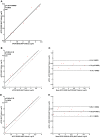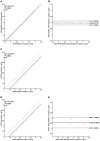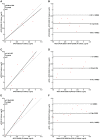Comparison among the Quantification of Bacterial Pathogens by qPCR, dPCR, and Cultural Methods
- PMID: 28702010
- PMCID: PMC5487435
- DOI: 10.3389/fmicb.2017.01174
Comparison among the Quantification of Bacterial Pathogens by qPCR, dPCR, and Cultural Methods
Abstract
The demand for rapid methods for the quantification of pathogens is increasing. Among these methods, those based on nucleic acids amplification (quantitative PCRs) are the most widespread worldwide. Together with the qPCR, a new approach named digital PCR (dPCR), has rapidly gained importance. The aim of our study was to compare the results obtained using two different dPCR systems and one qPCR in the quantification of three different bacterial pathogens: Listeria monocytogenes, Francisella tularensis, and Mycobacterium avium subsp. paratuberculosis. For this purpose, three pre-existing qPCRs were used, while the same primers and probes, as well as PCR conditions, were transferred to two different dPCR systems: the QX200 (Bio-Rad) and the Quant Studio 3D (Applied Biosystems). The limits of detection and limits of quantification for all pathogens, and all PCR approaches applied, were determined using genomic pure DNAs. The quantification of unknown decimal suspensions of the three bacteria obtained by the three different PCR approaches was compared through the Linear Regression and Bland and Altman analyses. Our results suggest that, both dPCRs are able to quantify the same amount of bacteria, while the comparison among dPCRs and qPCRs, showed both over and under-estimation of the bacteria present in the unknown suspensions. Our results showed qPCR over-estimated the amount of M. avium subsp. paratuberculosis and F. tularensis cells. On the contrary, qPCR, compared to QX200 dPCR, under-estimated the amount of L. monocytogenes cells. However, the maximum difference among PCRs approaches was <0.5 Log10, while cultural methods underestimated the number of bacteria by one to two Log10 for Francisella tularensis and Mycobacterium avium subsp. paratuberculosis. On the other hand, cultural and PCRs methods quantified the same amount of bacteria for L. monocytogenes, suggesting for this last pathogen, PCRs approaches can be considered as a valid alternative to the cultural ones.
Keywords: bacteria; dPCR; pathogens; qPCR; quantification.
Figures




Similar articles
-
Assessment of the real-time PCR and different digital PCR platforms for DNA quantification.Anal Bioanal Chem. 2016 Jan;408(1):107-21. doi: 10.1007/s00216-015-9107-2. Epub 2015 Oct 31. Anal Bioanal Chem. 2016. PMID: 26521179 Free PMC article.
-
A Rapid Method for Quantifying Viable Mycobacterium avium subsp. paratuberculosis in Cellular Infection Assays.Appl Environ Microbiol. 2016 Aug 30;82(18):5553-62. doi: 10.1128/AEM.01668-16. Print 2016 Sep 15. Appl Environ Microbiol. 2016. PMID: 27371585 Free PMC article.
-
A Duplex Digital PCR Assay for Simultaneous Quantification of the Enterococcus spp. and the Human Fecal-associated HF183 Marker in Waters.J Vis Exp. 2016 Mar 9;(109):53611. doi: 10.3791/53611. J Vis Exp. 2016. PMID: 27023488 Free PMC article.
-
Digital PCR for accurate quantification of pathogens: Principles, applications, challenges and future prospects.Int J Biol Macromol. 2021 Aug 1;184:750-759. doi: 10.1016/j.ijbiomac.2021.06.132. Epub 2021 Jun 24. Int J Biol Macromol. 2021. PMID: 34171259 Review.
-
Current commercial dPCR platforms: technology and market review.Crit Rev Biotechnol. 2023 May;43(3):433-464. doi: 10.1080/07388551.2022.2037503. Epub 2022 Mar 15. Crit Rev Biotechnol. 2023. PMID: 35291902 Review.
Cited by
-
Comparison of Real-Time PCR and Droplet Digital PCR for the Quantitative Detection of Lactiplantibacillus plantarum subsp. plantarum.Foods. 2022 May 3;11(9):1331. doi: 10.3390/foods11091331. Foods. 2022. PMID: 35564054 Free PMC article.
-
Comparison of culture and broad-range polymerase chain reaction methods for diagnosing periprosthetic joint infection: analysis of joint fluid, periprosthetic tissue, and sonicated fluid.Int Orthop. 2018 Sep;42(9):2035-2040. doi: 10.1007/s00264-018-3827-9. Epub 2018 Feb 11. Int Orthop. 2018. PMID: 29430604
-
Seasonal and Technological Shifts of the WHO Priority Multi-Resistant Pathogens in Municipal Wastewater Treatment Plant and Its Receiving Surface Water: A Case Study.Int J Environ Res Public Health. 2021 Dec 29;19(1):336. doi: 10.3390/ijerph19010336. Int J Environ Res Public Health. 2021. PMID: 35010596 Free PMC article.
-
Corynebacterium Species Inhibit Streptococcus pneumoniae Colonization and Infection of the Mouse Airway.Front Microbiol. 2022 Jan 10;12:804935. doi: 10.3389/fmicb.2021.804935. eCollection 2021. Front Microbiol. 2022. PMID: 35082772 Free PMC article.
-
Comparison of the intensity of biofilm formation by Listeria monocytogenes using classical culture-based method and digital droplet PCR.AMB Express. 2020 Apr 17;10(1):75. doi: 10.1186/s13568-020-01007-5. AMB Express. 2020. PMID: 32303851 Free PMC article.
References
-
- Anonymous (1998). ISO 11290-2: Microbiology of Food and Animal Feeding Stuffs - Horizontal Method for the Detection and Enumeration of Listeria monocytogenes - Part 2: Enumeration Method. Geneva.
-
- Anonymous (2005). COMMISSION REGULATION (EC) No 2073/2005 of 15 November 2005 on Microbiological Criteria for Foodstuffs. Rome.
-
- Anonymous (2009). ISO/TS 19036:2006: Microbiology of Food and Animal Feeding Stuffs – Guidelines for the Estimation of Measurement Uncertainty for Quantitative Determinations. Geneva: AMEDMENT 1.
-
- Anonymous (2012). ISO/TS 12869: Water quality — Detection and Quantification of Legionella spp. and/or Legionella pneumophila by Concentration and Genic Amplification by Quantitative Polymerase Chain reaction (qPCR). Geneva.
-
- Anonymous (2014). OIE Validation Guidelines (2014). VALIDATION GUIDELINE 3.6.5. STATISTICAL APPROACHES TO VALIDATION. Paris: World Organisation for Animal Health, 1–12.
LinkOut - more resources
Full Text Sources
Other Literature Sources
Molecular Biology Databases

